HR On-boarding and Orientation Policy Template
1. Purpose
This policy establishes a standardized process for welcoming, integrating, and orienting new employees to ensure a smooth transition into the organization. The on-boarding program aims to provide new hires with the knowledge, resources, and support needed to become productive and engaged team members.
2. Scope
This policy applies to all new employees, including full-time, part-time, temporary, and contract workers joining the organization.
3. Policy Statement
The organization is committed to providing a comprehensive on-boarding experience that introduces new employees to the company culture, values, policies, and procedures while equipping them with the tools necessary for success in their roles.
4. Roles and Responsibilities
4.1 Human Resources Department
Coordinate and oversee the entire on-boarding process
Prepare on-boarding materials and documentation
Conduct orientation sessions
Ensure completion of all required paperwork
Track on-boarding progress and gather feedback
4.2 Hiring Manager
Prepare the workspace and equipment before the start date
Introduce new employee to team members and key stakeholders
Provide role-specific training and guidance
Set clear expectations and performance objectives
Conduct regular check-ins during the probationary period
4.3 Assigned Buddy/Mentor
Serve as a point of contact for day-to-day questions
Provide informal guidance on company culture and norms
Facilitate social integration within the team
4.4 IT Department
Set up computer systems, email accounts, and access credentials
Provide technology orientation and support
5. Pre-boarding (Before Day One)
5.1 Timeline: 1-2 weeks before start date
Send welcome email with first-day logistics
Complete all background checks and employment verification
Prepare employment contract and necessary paperwork
Set up workstation, computer, phone, and email account
Order business cards, ID badge, and any required equipment
Assign a buddy/mentor
Notify relevant departments of the new hire
Prepare on-boarding schedule and materials
6. Day One Orientation
6.1 Welcome and Introduction (First Hour)
Warm welcome by HR representative
Office tour including restrooms, break rooms, emergency exits
Introduction to immediate team members
Workspace setup and equipment overview
6.2 Administrative Tasks (Morning)
Complete employment documentation (tax forms, direct deposit, emergency contacts)
Review and sign employee handbook acknowledgment
Complete benefits enrollment
Receive ID badge, keys, and access cards
IT setup and system access verification
6.3 Company Overview (Afternoon)
Company history, mission, vision, and values
Organizational structure and key departments
Products, services, and target markets
Company policies and procedures overview
Introduction to employee benefits and perks
6.4 End of Day One
Provide employee handbook and reference materials
Schedule follow-up meetings for week one
Address any immediate questions or concerns
7. First Week On-boarding
7.1 Days 2-5 Activities
Department-specific orientation
Role-specific training sessions
Introduction to key stakeholders and cross-functional teams
Review of job description and performance expectations
Assignment of initial tasks and projects
Daily check-ins with manager and buddy
7.2 Key Topics to Cover
Communication channels and protocols
Time and attendance procedures
Expense reporting and approval processes
Safety and security procedures
Access to company resources and systems
Dress code and workplace conduct expectations
8. First 30-90 Days
8.1 30-Day Milestones
Complete all mandatory training programs
One-on-one meeting with manager to review progress
Set short-term goals and objectives
HR check-in to address questions and concerns
8.2 60-Day Milestones
Mid-probation performance review
Increased responsibility and autonomy
Continued skill development and training
8.3 90-Day Milestones
Comprehensive performance evaluation
Discussion of long-term career development
Feedback session on on-boarding experience
Final probationary period review
9. Training and Development
9.1 Mandatory Training
All new employees must complete the following within their first 30 days:
Workplace safety and emergency procedures
Anti-harassment and discrimination prevention
Data security and confidentiality
Code of conduct and ethics
Compliance training (industry-specific)
9.2 Role-Specific Training
Technical skills and systems training
Job-specific procedures and protocols
Customer service standards (if applicable)
10. On-boarding Checklist
HR will maintain a comprehensive checklist covering:
Pre-boarding tasks completion
Day one activities completion
First week milestones
30-60-90 day check-ins
Training completion verification
Documentation collection and filing
11. Feedback and Continuous Improvement
11.1 New Employee Survey
Administer survey at 30 and 90 days
Gather feedback on on-boarding experience
Identify areas for improvement
11.2 Program Evaluation
Review on-boarding metrics quarterly
Assess time-to-productivity rates
Monitor new hire retention rates
Update on-boarding materials as needed
12. Remote and Hybrid Employee On-boarding
For remote or hybrid workers:
Ship equipment and materials prior to start date
Conduct virtual orientation sessions
Schedule video calls for introductions
Provide digital access to all resources
Arrange periodic in-office visits when possible
Ensure clear communication channels are established
13. Special Circumstances
13.1 Rehires
Abbreviated orientation focusing on updates and changes
Review of any new policies or procedures
13.2 Internal Transfers
Department-specific orientation
Introduction to new team and stakeholders
Review of new role responsibilities
14. Documentation and Record Keeping
All on-boarding documentation must be:
Completed accurately and in a timely manner
Stored securely in employee personnel files
Maintained in compliance with legal requirements
Accessible to authorized personnel only
15. Policy Review
This policy will be reviewed annually and updated as necessary to reflect best practices, legal requirements, and organizational changes.
Effective Date: [Insert Date]
Policy Owner: Human Resources Department
Approved By: [Name/Title]
Next Review Date: [Insert Date]
HR On-boarding and Orientation Policy Template
1. OBJECTIVE
Onboarding new employees involves providing them key information on the culture, way of working, policies etc., in order to help them develop an overall understanding of the organization. This ensures they integrate sooner into the organization and enables effectivity and productivity at the earliest.
The objective of this policy is to ensure that all new employees undergo a structured and standardized onboarding program. Additionally, it provides the role expectations from key stakeholders to create a professional and comfortable experience for all new hires.
2. POLICY GUIDELINES
We aim to ensure all employees feel welcomed and are comfortably blending and transitioning within the organization. From an employee's offer acceptance to first day of joining and till their confirmation, we all collaboratively strive to provide them with all the necessary support in terms of knowledge, skills and attitude. This will help them acclimatize with the overall organization culture, working norms as well as their job roles throughout their tenure.
2.1. From Offer acceptance to Joining Day
2.1.1. Once the candidate has signed the Offer letter, their authenticated academic certificates copies are collected.
2.1.2. HR department prepares the employee file, send the details to Public Relations (PR) department, who processes the application and send the Ministry Offer Letter (MOL) to the HR department. This is shared with the new employee by the HR. On receiving the signed MOL, it is sent to the PR department for visa application. On receiving the Visa, a copy is sent to the employee. A tentative joining date is also discussed.
2.1.3. For accommodation requests/ requirements kindly refer to the Accommodation Policy.
2.1.4. The HR coordinates with the Learning and Development (L&D) team for the Orientation schedule.
2.1.5. A joining email is sent to the employee confirming the date and time of joining. Joining process is limited to twice a month. E.g. 1st & 3rd Sunday or 2nd & 4th Sunday.
2.1.6. Preparations are done internally Jo ensure administrative ease for the employee's first day in the organization. This includes Welcome Kit, Laptop, Email id set up, Business Cards, work station etc.
2.1.7. A new joiner email is sent out within a week of joining, across the group to all employees for Managers & above, across the vertical/ unit for below Managers by the Business HR.
2.2. New Joiner Orientation Program
2.2.1. The process begins with employees joining the organization and undergoing the Orientation Program.
2.2.2. This will be a 1-day Orientation Program.
2.2.3. The Orientation Program is conducted once in a month providing a broad overview about the organization, business verticals and sensitizing the new hires towards Clinical and Service Excellence standards of the Group.
Welcome Kit:
At the start of the orientation program each employee is given a welcome kit which includes organization branded merchandise - diary, pen, flask, ID Cards & forms (for certain documentation).
Program Framework:
The program is designed focusing on three key elements which includes overview of the group & the business, functioning of various departments, quality & safety standards.
Role Specific Training:
•The New Hire Orientation Program concludes with employees commencing their role-based trainings to equip them with the knowledge and skills required to cope up with their job responsibilities.
•These role specific trainings last from a few days up to a month in some verticals/ functions depending on the business needs.
•Role specific trainings can take place within the area of work or separately depending on the requirements of the job role/ function.
•Primarily, these role specific trainings across the organization are broadly classified as Clinical/ Medical/Retail trainings which sharpen the technical and functional skills; and Service and Leadership Developmental trainings which enhance the behavioral skillset.
•The role specific trainings ensure that employees are provided with Clinical and Service Excellence principles and guidelines; thus, providing clarity to each new hire and setting clear expectations for them to be successful in their job roles.
2.3. Feedback & Evaluation for New Employees
At the end of the first month of joining, a formal experience survey is conducted to understand the initial settling experience of the new employee. This formal survey is also supported by the one-on-one formal or informal interaction with the HR to receive firsthand feedback and provide support/ clarity wherever required.
For Organizers:
•Participants' orientation feedback is documented by the L&D team and provided to the HR.
•These feedbacks are consolidated and shared by the Learning and Development (L&D) team with all the speakers and heads of departments on a monthly basis.
•The statistics of these sessions are also shared with the Senior Management on a monthly basis.
2.4. Probation Completion
The onboarding process is completed with the probation confirmation of the employee with the organization.
3.DISCLAIMER
3.1. The policy and procedures explained in this document may change at any time, at the sole discretion of the Management of [Company Name], without prior notice. No statement or promise by a supervisor, manager or department head may be interpreted as a change in policy nor will it constitute an agreement with an employee.
3.2. This policy document should be read in conjunction with Local Labor laws which for the avoidance of doubt will take precedence over this policy document.
3.3. This policy document shall be effective from the 1late of issuance and supersede all previous procedures and understandings pertaining to the subject.
4.APPENDICES
What is an HR On-boarding and Orientation Policy Letter?
HR on-boarding and orientation policy letters are official communications that guide new employees through their initial integration into the organization. These letters serve multiple purposes: confirming employment details, outlining expectations, scheduling orientation activities, and ensuring compliance with organizational policies. They create a structured framework for the transition from candidate to employee, reducing anxiety and establishing clear communication channels from day one.
Who Should Send These Letters?
- HR Department - Primary sender for most on-boarding communications
- Hiring Manager - Welcome letters and team-specific information
- Department Head - Official confirmations and policy acknowledgments
- CEO or Executive Leadership - Company-wide welcome messages for senior positions
- IT Department - System access and technology setup letters
- Facilities Manager - Workspace and logistics communications
- Training Coordinator - Learning and development schedules
When Should These Letters Be Sent?
- Immediately after offer acceptance
- 2-3 weeks before start date (pre-boarding communication)
- 1 week before start date (final reminders and confirmations)
- First day of employment (welcome and orientation schedule)
- During first week (follow-up and check-in communications)
- End of probationary period (evaluation and confirmation)
- When policy changes affect new hires
- Upon completion of orientation milestones
Elements and Structure of On-boarding Letters
- Subject Line - Clear, specific, and actionable
- Personalized Greeting - Use employee's preferred name
- Purpose Statement - Immediate clarity on letter's intent
- Key Information - Dates, times, locations, requirements
- Action Items - What the employee needs to do
- Contact Information - Who to reach for questions
- Attachments - Forms, documents, schedules, maps
- Timeline - Deadlines and important dates
- Professional Closing - Warm yet professional sign-off
- Signature Block - Name, title, department, contact details
Pre-Start Welcome and Preparation Email
Subject: Welcome to [Company Name] - Your First Day Preparation
Dear [Employee Name],
Congratulations and welcome to the [Company Name] team! We are thrilled that you will be joining us as [Job Title] on [Start Date]. Your skills and experience will be a valuable addition to our [Department Name].
To help you prepare for your first day, please find the following important details:
Start Date and Time: [Date] at [Time]
Report To: [Building Name/Address]
Parking: [Parking instructions or pass information]
Dress Code: [Business casual/Professional/Casual]
Contact Person: [Name] at [Phone/Email]
Please bring the following on your first day:
- Two forms of identification (for I-9 verification)
- Voided check or bank details for direct deposit
- Completed forms (attached to this email)
- Any questions you may have
Your first week will include orientation sessions, team introductions, system training, and meetings with your manager to discuss your role and initial projects. We will provide lunch on your first day, and your workspace will be fully set up and ready for you.
If you have any questions before your start date, please don't hesitate to reach out to me directly at [Email] or [Phone].
We look forward to seeing you soon!
Best regards,
[HR Representative Name]
[Title]
[Company Name]
First Day Welcome and Orientation Schedule Letter
Subject: Your First Day Schedule at [Company Name]
Dear [Employee Name],
Welcome to your first day at [Company Name]! We are excited to have you join our team.
Your schedule for today:
8:30 AM - Arrival and Check-in (Reception, [Building/Floor])
9:00 AM - HR Orientation and Paperwork (Conference Room A)
10:30 AM - Office Tour and Introductions
11:30 AM - IT Setup and System Access (IT Department)
12:30 PM - Welcome Lunch with Your Team
2:00 PM - Meeting with Your Manager, [Manager Name]
3:30 PM - Department Overview and Initial Project Discussion
5:00 PM - End of Day Check-in with HR
Please arrive at Reception by 8:30 AM where [Receptionist Name] will greet you and provide your temporary access badge. Bring the documents requested in our previous email.
Your buddy/mentor, [Buddy Name], will accompany you throughout the day to help you navigate the office and answer any questions. Feel free to ask them anything!
Lunch is on us today at [Restaurant/Cafeteria]. This is a great opportunity to meet your immediate team members in a relaxed setting.
Looking forward to meeting you!
Warm regards,
[HR Representative Name]
[Title]
Formal Employment Confirmation Letter
Subject: Official Employment Confirmation - [Employee Name]
Dear [Employee Name],
This letter serves as official confirmation of your employment with [Company Name] effective [Start Date].
Position: [Job Title]
Department: [Department Name]
Reporting To: [Manager Name and Title]
Employment Type: [Full-time/Part-time/Contract]
Work Location: [Office Location/Remote/Hybrid]
Salary: [Amount] per [year/month], paid [bi-weekly/monthly]
Benefits Eligibility: [Date benefits begin]
Your employment is subject to the successful completion of our standard probationary period of [90/180] days, during which your performance will be evaluated. Upon satisfactory completion, your employment will be confirmed as permanent.
This position is governed by the terms outlined in your employment contract dated [Contract Date] and the employee handbook, both of which you will receive during orientation. You are expected to comply with all company policies and procedures.
Please acknowledge receipt of this letter by signing and returning the attached copy by [Date].
We are confident you will make significant contributions to our organization and wish you success in your new role.
Sincerely,
[HR Director Name]
[Title]
[Company Name]
Casual Team Welcome Email
Subject: Welcome to the Team! 🎉
Hey [Employee Name],
The whole team is super excited that you're joining us! We wanted to reach out and say welcome before your official start date.
We're a pretty laid-back group, but we work hard and support each other. Here are a few things to know about us:
We do coffee runs at 10 AM (your order is on us for the first week!)
Lunch crew usually heads out around 12:30 - you're always welcome to join
Friday afternoons we have casual team catch-ups
We have a shared playlist - add your favorite work tunes!
Don't stress about your first day. Everyone here remembers being the new person, and we've got your back. Your desk is right next to [Colleague Name], who's been with us for [time period] and knows everything about everything.
If you want to grab coffee before your official start to ask any questions or just chat, let me know. Otherwise, see you on [Start Date]!
Cheers,
[Team Lead Name]
[Department]
IT Systems Access and Setup Email
Subject: IT Systems Setup - Action Required Before [Start Date]
Dear [Employee Name],
Welcome to [Company Name]! Our IT team has begun setting up your technology access and equipment for your start date.
Your Equipment:
- [Laptop Model/Desktop] - Ready at your workstation
- [Monitor/Accessories] - Already configured
- [Phone Extension] if applicable
- [Security Badge] - Collect from Reception on Day 1
Your Accounts (credentials will be provided on Day 1):
- Email: [email address]
- Company Intranet Access
- [Software/Systems specific to role]
- VPN Access (if remote work applies)
Action Required Before Your Start Date:
Please create your Microsoft/Google account password at [link] using the temporary credentials sent in a separate secure email. This must be completed by [Date] to ensure system access on your first day.
On your first day, report to the IT Department at 11:30 AM (see orientation schedule) where we will:
- Provide your equipment and login credentials
- Set up multi-factor authentication
- Install required software
- Configure email and calendar
- Answer any technical questions
Important Security Notes:
Never share your passwords with anyone
Enable multi-factor authentication on all systems
Report any suspicious emails to security@[company].com
For urgent IT questions before your start date, contact our helpdesk at [Phone/Email].
Best regards,
[IT Manager Name]
IT Department
Benefits Enrollment Reminder Email
Subject: Benefits Enrollment Deadline - Action Required
Dear [Employee Name],
As you settle into your new role, we want to remind you about your benefits enrollment deadline.
You are eligible to enroll in the following benefits effective [Date]:
- Health Insurance (Medical, Dental, Vision)
- Retirement Plan (401k with company match)
- Life Insurance
- Disability Insurance
- Flexible Spending Accounts
Enrollment Deadline: [Date] - This is [X] days away!
To enroll:
1. Log into the benefits portal at [URL]
2. Review the benefits guide (attached)
3. Select your coverage options
4. Designate beneficiaries
5. Submit your enrollment by the deadline
If you miss this deadline, you will have to wait until the next open enrollment period ([Month/Year]) unless you experience a qualifying life event.
Our benefits team is available to answer questions and help you make informed decisions. Schedule a one-on-one consultation by replying to this email or calling [Phone Number].
Benefits Orientation Session: [Date and Time] in [Location/Virtual Link]
Don't leave this to the last minute - your health and financial security matter!
Best regards,
[Benefits Coordinator Name]
HR Department
30-Day Check-in and Feedback Request Email
Subject: Your First Month at [Company Name] - Let's Connect
Dear [Employee Name],
It's hard to believe you've been with us for a month already! We hope you're settling in well and finding your groove with the team.
As part of our on-boarding process, we'd like to check in with you to see how things are going. Your feedback is valuable and helps us improve the experience for future new hires.
Please take 15 minutes to complete this brief survey by [Date]: [Survey Link]
We'd also like to schedule a casual check-in meeting with you. This is an opportunity to:
- Discuss how your first month has been
- Address any challenges or concerns
- Clarify expectations and goals
- Answer any questions you might have
- Gather your suggestions for improvement
Please reply with your availability for a 30-minute meeting during the week of [Date Range].
Your manager will also be conducting a separate check-in to discuss your role-specific progress and provide feedback on your initial projects.
Remember, your success is our success. We're here to support you!
Looking forward to hearing from you,
[HR Representative Name]
[Title]
Probation Completion and Confirmation Letter
Subject: Probationary Period Completion - Congratulations!
Dear [Employee Name],
Congratulations! We are pleased to inform you that you have successfully completed your probationary period as of [Date].
Based on performance evaluations from your manager and feedback from your colleagues, you have demonstrated:
- Strong technical skills and competence in your role
- Excellent collaboration and team integration
- Commitment to our company values and culture
- Consistent professionalism and reliability
Your employment is now confirmed as permanent, effective immediately. This confirmation includes:
- Full eligibility for all employee benefits and programs
- Access to professional development opportunities
- Eligibility for performance bonuses and increases
- Standard notice period terms as per your contract
Your manager, [Manager Name], will schedule a meeting to discuss your performance review in detail, set goals for the coming period, and outline your development plan.
We are thrilled to have you as a permanent member of our team and look forward to your continued contributions to [Company Name].
Once again, congratulations on this milestone!
Sincerely,
[HR Director Name]
[Title]
[Company Name]
Remote Employee On-boarding Package Email
Subject: Remote On-boarding Details - [Company Name]
Dear [Employee Name],
Welcome to [Company Name]! As a remote team member, your on-boarding experience will be a bit different, but equally comprehensive and supportive.
Your Equipment Shipment:
Your laptop, accessories, and welcome package have been shipped via [Carrier] to the address you provided. Tracking number: [Number]. Expected delivery: [Date]. Please confirm receipt when it arrives.
Virtual Orientation Schedule (All times in [Time Zone]):
[Date] at [Time] - Virtual Welcome Session (Zoom link below)
[Date] at [Time] - HR Orientation and Paperwork
[Date] at [Time] - IT Systems Training
[Date] at [Time] - Virtual Team Meet-and-Greet
[Date] at [Time] - One-on-one with Your Manager
Zoom Links: [Provide links or calendar invites]
Remote Work Expectations:
- Core working hours: [Time Range]
- Daily team check-in: [Time]
- Communication tools: Slack, Zoom, Email
- Response time expectations: [Details]
- Home office stipend: [Amount] (details in employee handbook)
Before Your Start Date:
- Test your internet connection (minimum [Speed] required)
- Set up a dedicated workspace
- Install [Software] from the links provided
- Complete background check authorization (if not done)
You've been assigned a remote buddy, [Buddy Name], who will reach out separately to help you navigate your first few weeks virtually.
Questions before your start date? Email me anytime or schedule a call: [Calendar Link]
Excited to have you on board!
Best regards,
[HR Representative Name]
[Title]
Policy Acknowledgment and Compliance Letter
Subject: Required Policy Acknowledgments - Action Required by [Date]
Dear [Employee Name],
As part of your on-boarding process, you are required to review and acknowledge several company policies that govern your employment.
Please log into the HR portal at [URL] and complete the following by [Deadline Date]:
1. Employee Handbook - Read and sign acknowledgment
2. Code of Conduct - Review and accept
3. Confidentiality and Non-Disclosure Agreement - Sign electronically
4. Data Protection and Privacy Policy - Acknowledge
5. Social Media Policy - Review and accept
6. Health and Safety Guidelines - Complete and confirm
7. Anti-Harassment and Discrimination Policy - Acknowledge understanding
These policies are mandatory for all employees and failure to complete acknowledgments by the deadline may delay your access to certain systems and facilities.
Each policy includes a brief quiz to ensure understanding. Passing score is 80%. You may retake quizzes if needed.
Estimated time to complete all acknowledgments: 60-90 minutes
If you have questions about any policy, please contact HR before signing. We want you to fully understand your rights and responsibilities.
Your completion status: [X] of [Y] policies acknowledged
Thank you for your prompt attention to this matter.
Regards,
[HR Compliance Officer Name]
[Title]
How to Write Effective On-boarding Letters
- Personalize every communication - Use the employee's name and specific details about their role
- Be clear and concise - New employees are overwhelmed; make information easy to digest
- Use welcoming language - Balance professionalism with warmth
- Provide actionable information - Always include what, when, where, and who to contact
- Anticipate questions - Address common concerns proactively
- Include all necessary attachments - Don't make employees search for forms
- Set appropriate tone - Match formality to message purpose
- Proofread carefully - Errors create poor first impressions
- Use consistent branding - Include company logo and formatting standards
Requirements and Prerequisites Before Sending
- Offer letter must be signed and accepted
- Background check completed (if required)
- All hiring approvals finalized
- Employee start date confirmed
- Workspace and equipment prepared
- System accounts created or requested
- Manager notified and oriented schedule cleared
- Orientation materials prepared
- Required forms and documents ready
- Team members informed of new hire
- Buddy/mentor assigned
- Access badges ordered
- Benefits enrollment information prepared
Common Mistakes to Avoid
- Sending information overload in one email instead of spacing communications
- Using jargon or acronyms unfamiliar to new employees
- Providing conflicting information across different letters
- Missing critical details like parking, dress code, or what to bring
- Sending letters too late or too early
- Forgetting to attach referenced documents
- Using impersonal, template language without customization
- Not providing clear contact person for questions
- Overlooking remote employee specific needs
- Failing to confirm receipt of important documents
- Sending from generic HR email without specific contact
- Not coordinating timing with manager and IT department
After Sending Follow-up Actions
- Confirmation tracking - Monitor whether employee opened and read emails
- Document receipt - Ensure signed forms are returned by deadlines
- Respond promptly - Answer questions within 24 hours
- Coordinate with departments - Confirm IT, facilities, and managers are ready
- Send reminders - For action items approaching deadlines
- Update systems - Record completed requirements in HR system
- Prepare for Day 1 - Final check that everything is ready
- Schedule check-ins - Set calendar reminders for 30/60/90 day reviews
- Gather feedback - Survey new hires about on-boarding experience
- Improve process - Use feedback to refine future communications
Best Practices and Tips
- Create an on-boarding communication calendar with all touchpoints mapped
- Use email templates but always personalize key details
- Send pre-boarding communication 2-3 weeks before start date to maintain engagement
- Include a FAQ document to reduce repetitive questions
- Provide virtual office tour video for remote employees
- Create a "First Day Survival Guide" with practical tips
- Assign a buddy before start date for informal questions
- Use multiple communication channels (email, phone, portal)
- Include manager in key communications to build relationship early
- Celebrate the new hire with team announcement
- Provide emergency contact information for first day issues
- Record orientation sessions for later reference
- Create a 90-day roadmap showing key milestones
Formatting Guidelines
- Email length - Keep individual emails under 300 words when possible; use attachments for detailed information
- Letter length - Formal letters should be 1-2 pages maximum
- Tone - Professional yet welcoming; avoid overly formal or casual extremes
- Subject lines - Clear, specific, and action-oriented
- Formatting - Use bullet points, bold headings, and white space for readability
- Response time - Indicate when employee can expect responses to questions
- Attachments - Name files clearly (e.g., "FirstDay_Checklist_EmployeeName.pdf")
- Branding - Use company letterhead for formal letters
- Font and style - Consistent with company standards, readable on mobile devices
- Call to action - Make required actions clear and prominent
Pros and Cons of Structured On-boarding Letters
Advantages:
- Creates professional first impression
- Reduces new employee anxiety through clear communication
- Ensures consistency across all new hires
- Documents important information for legal compliance
- Sets expectations clearly from the start
- Reduces HR workload through automation
- Helps new employees feel valued and welcomed
- Provides reference material employees can revisit
Disadvantages:
- Can feel impersonal if not customized
- Information overload if too many letters sent at once
- Requires maintenance to keep templates current
- May not address unique individual circumstances
- Digital communications can be overlooked or go to spam
- Time-consuming to personalize for each hire
- Can create anxiety if too formal or compliance-focused
Comparison with Alternative On-boarding Methods
Letters vs. Phone Calls: Letters provide documentation and can be referenced later, while phone calls offer personal connection but no paper trail.
Email vs. Postal Mail: Email is faster and allows attachments, but formal offer letters often require postal mail for legal reasons.
Automated vs. Personalized: Automated systems ensure consistency and save time, but personalized letters create stronger emotional connection.
Portal-Based vs. Email: HR portals centralize information but require logins; emails are more immediate but can be lost.
Video Messages vs. Written: Video adds personal touch for welcome messages, but written communication is better for detailed instructions and compliance requirements.


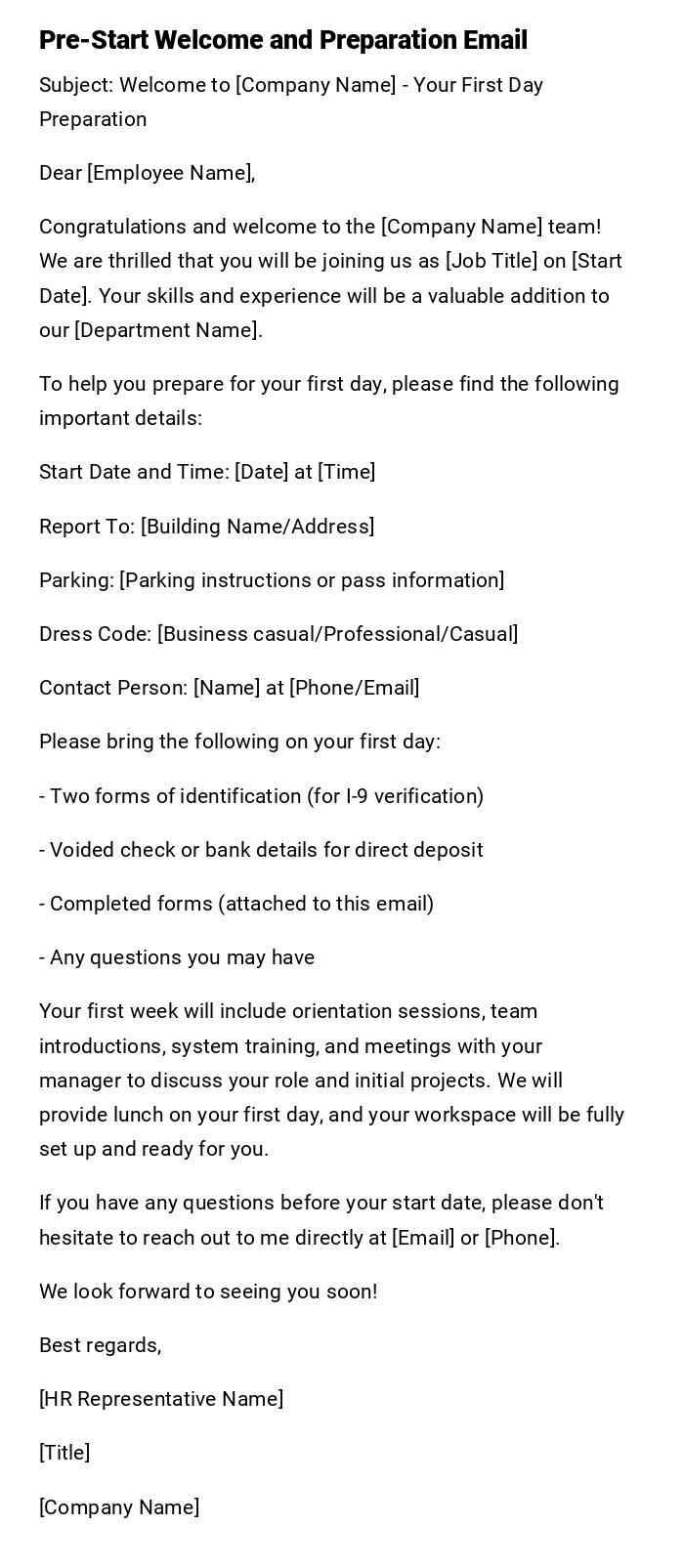
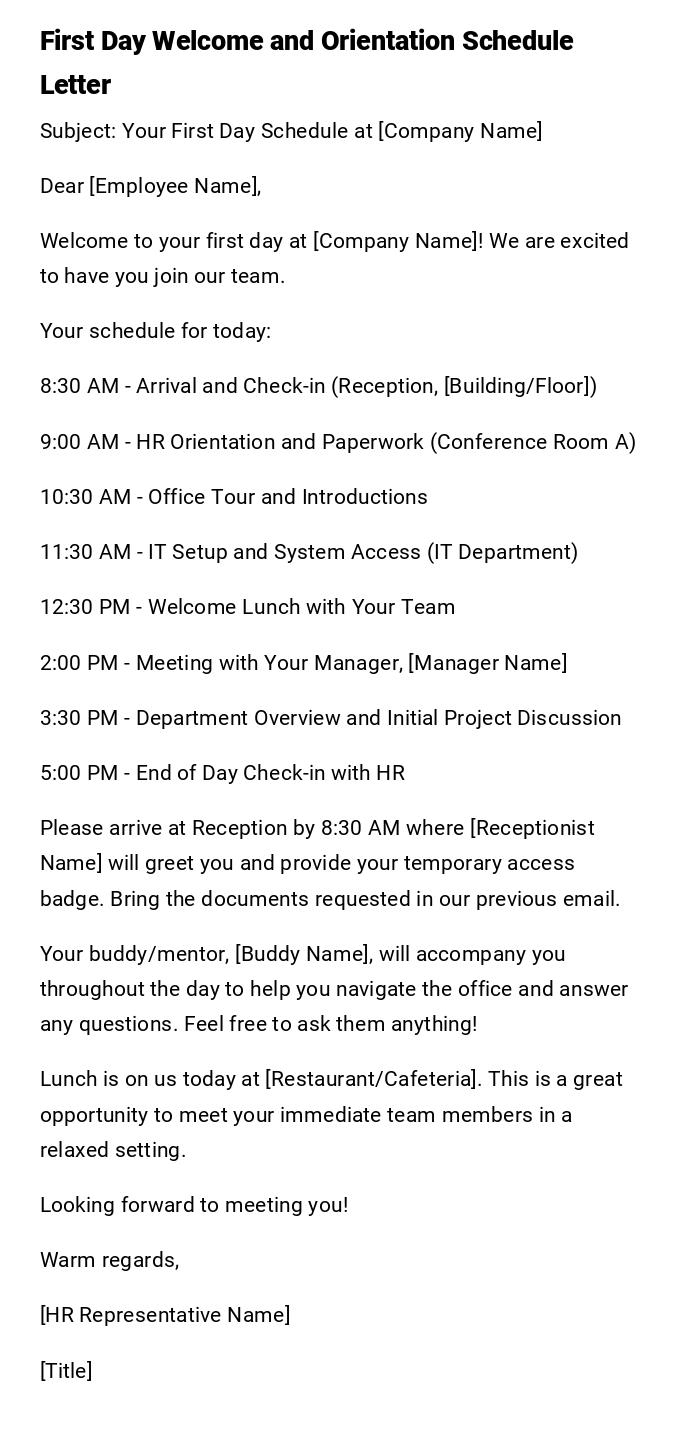
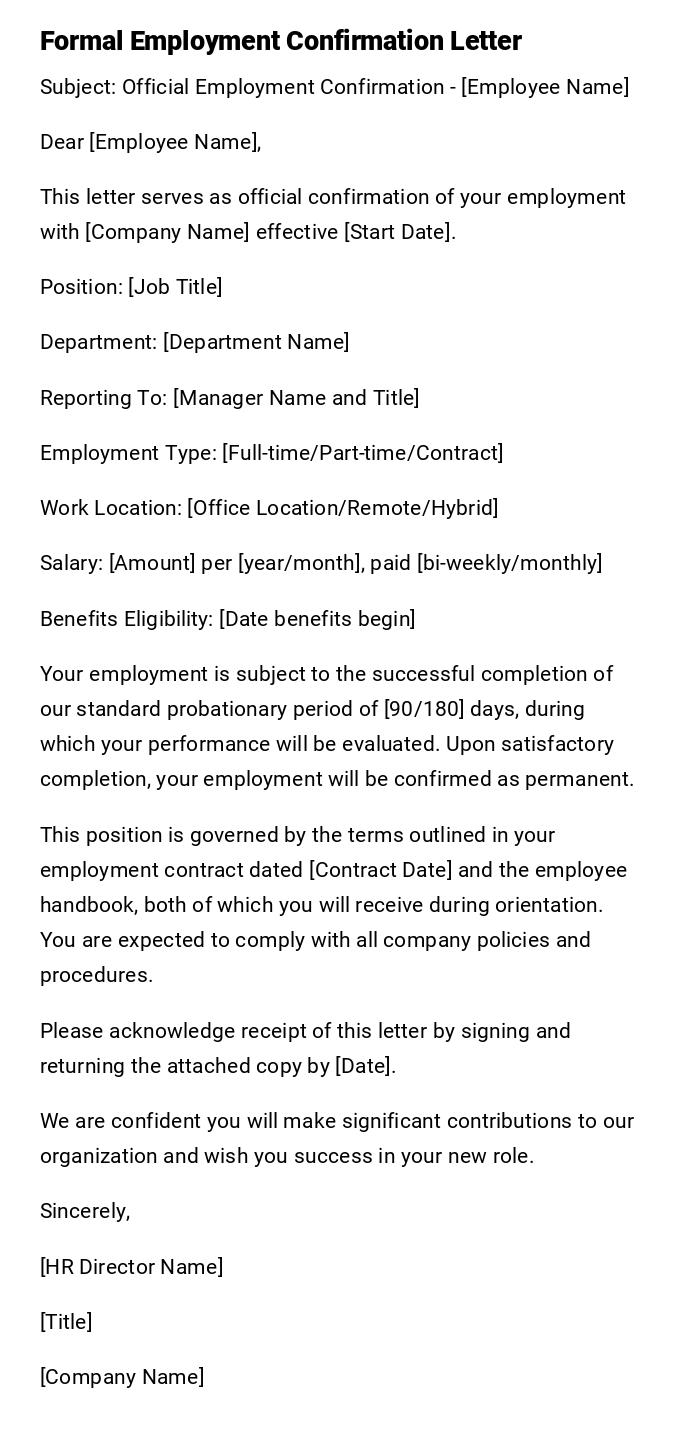
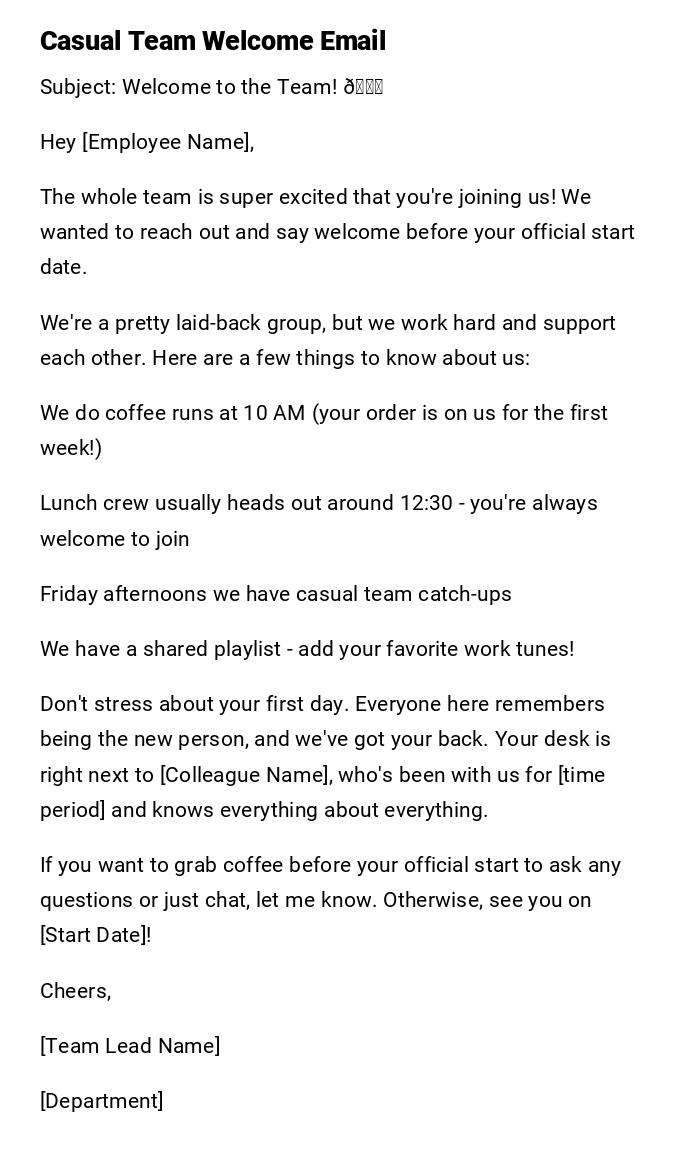
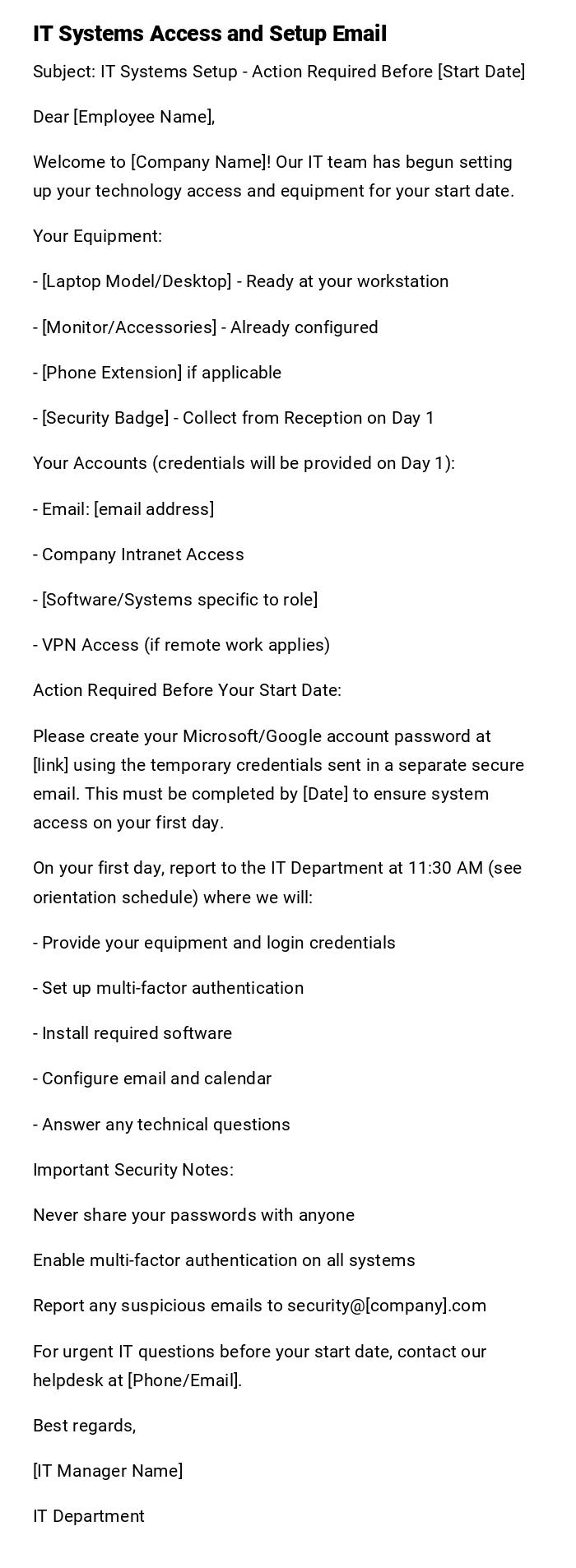
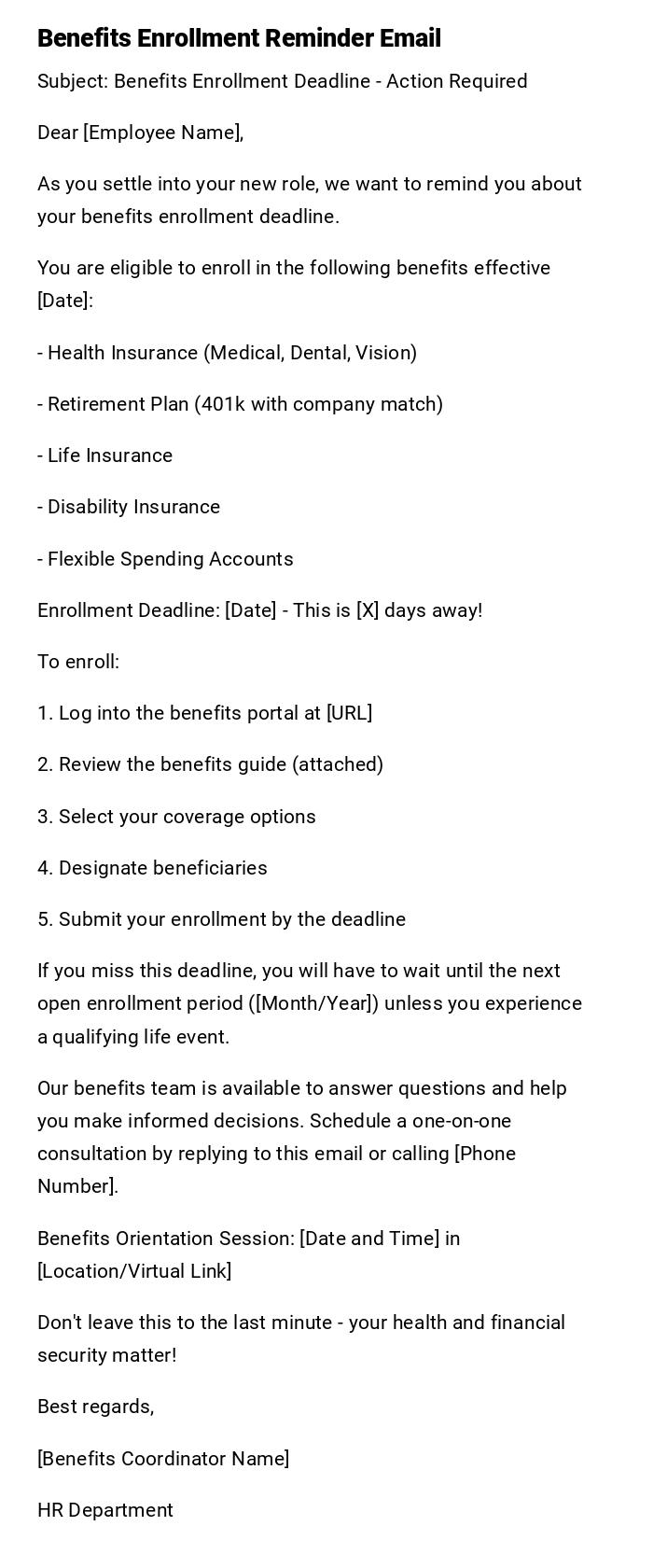
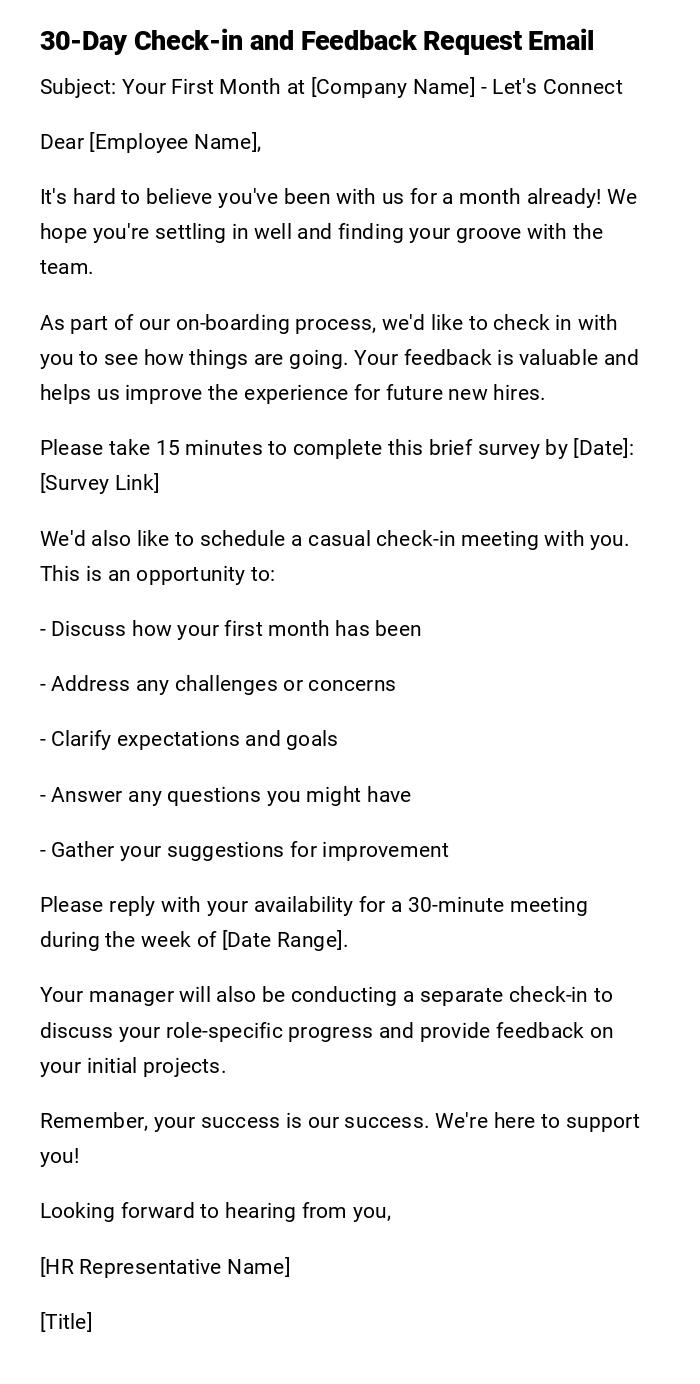
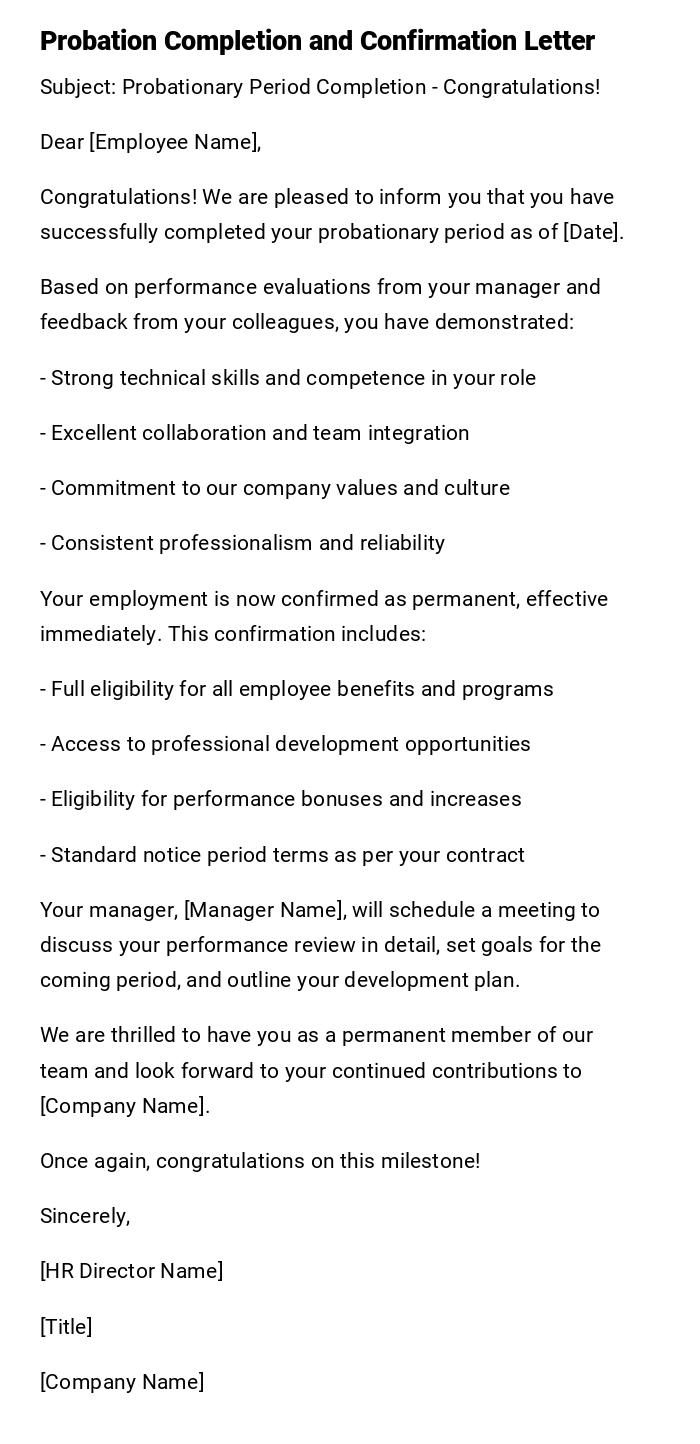
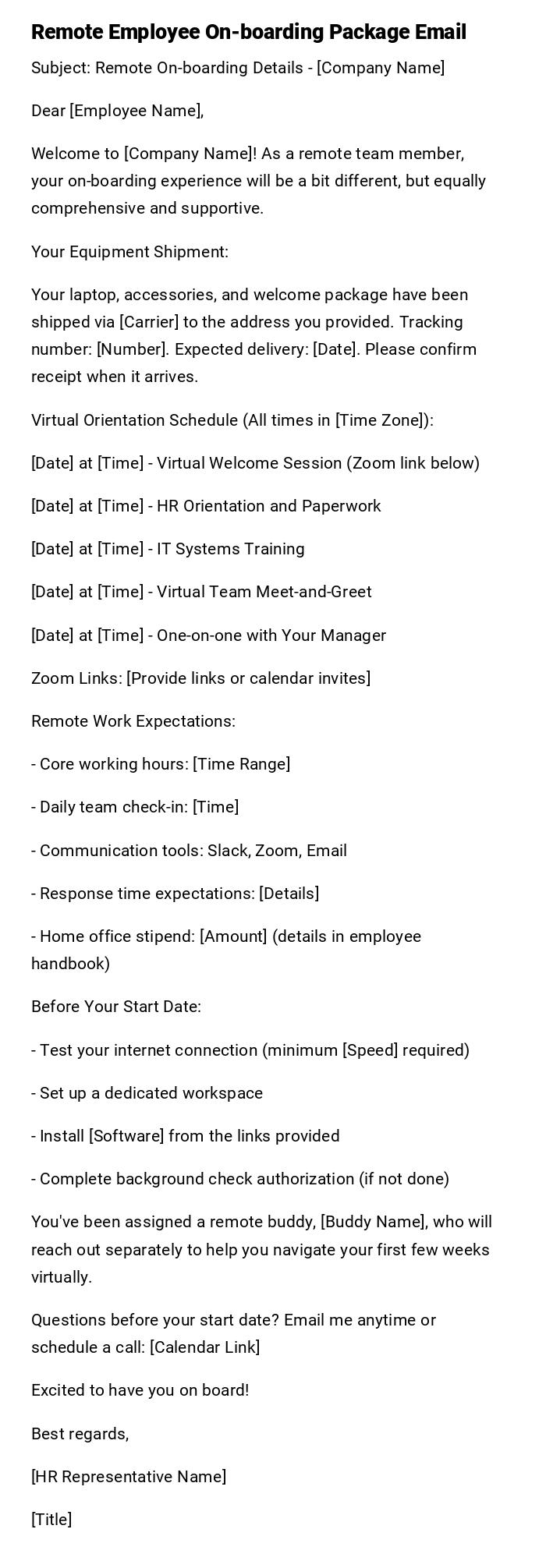
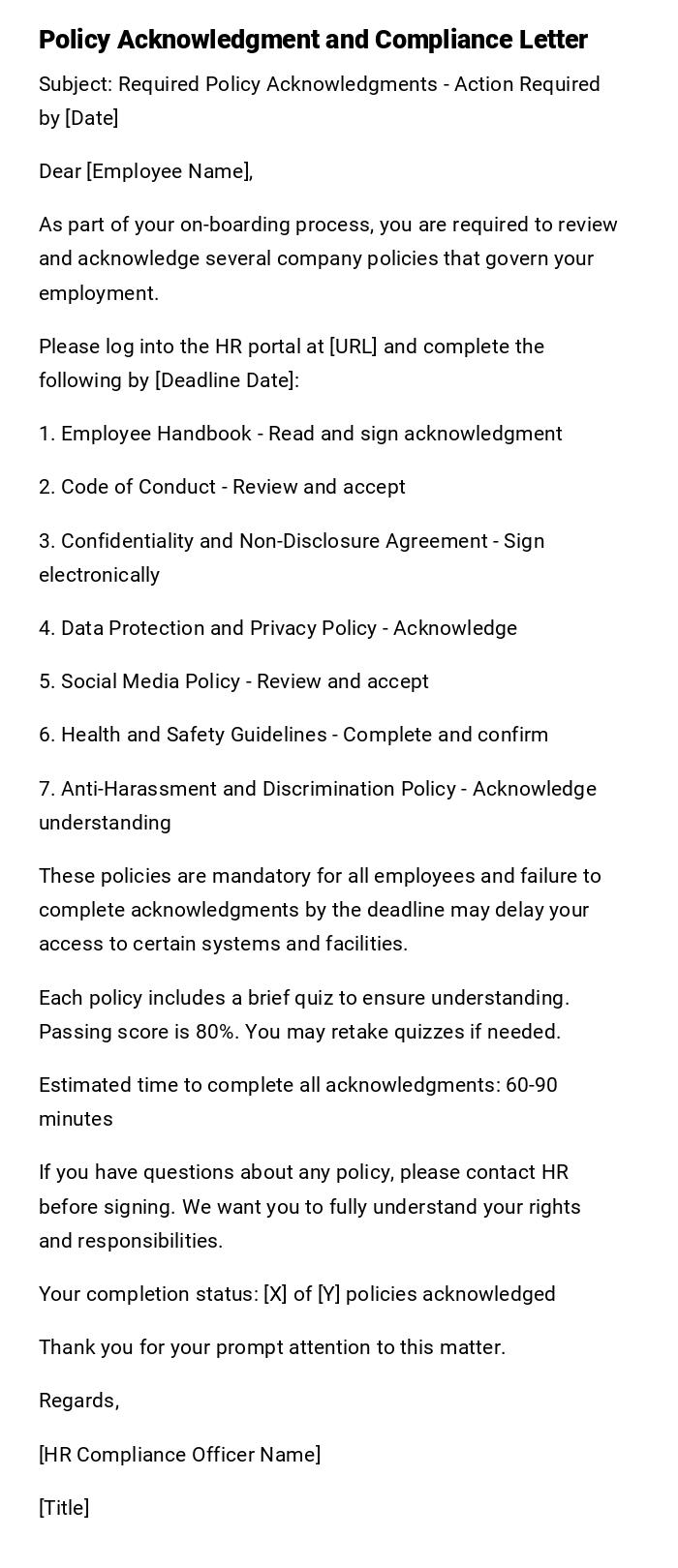

 Download Word Doc
Download Word Doc
 Download PDF
Download PDF